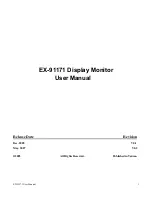
13
English
On the other hand, because the radio waves can
travel through obstacles (such as walls) and are
available everywhere within a given range, problems
of the type listed below may occur if security-related
settings are not made.
•
A malicious third-party may intentionally intercept
and monitor transmitted data including the content
of e-mail and personal information such as your ID,
password, and/or credit card numbers.
•
A malicious third-party may access your personal
or corporate network without authorization and
engage in the following types of behaviour.
Retrieve personal and/or secret information
(information leak)
Spread false information by impersonating a
particular person (spoofing)
Overwrite intercepted communications and issue
false data (tampering)
Spread harmful software such as a computer virus
and crash your data and/or system (system crash)
●
Since most wireless LAN adapters or access points
are equipped with security features to take care of
these problems, you can reduce the possibility of
these problems occurring when using this product
by making the appropriate security settings for the
wireless LAN device.
●
Some wireless LAN devices may not be set for
security immediately after purchase. To decrease the
possibility of occurrence of security problems, before
using any wireless LAN devices, be absolutely sure
to make all security-related settings according to the
instructions given in the operation manuals supplied
with them.
Depending on the specifications of the wireless LAN,
a malicious third-party may be able to break security
settings by special means.
Please contact Panasonic if you need help taking
care of security settings or other such.
If you cannot perform security settings for your
wireless LAN by yourself, please contact the
Panasonic Support Center.
●
Panasonic asks customers to thoroughly understand
the risk of using this product without making security
settings, and recommends that the customer
make security settings at their own discretion and
responsibility.
About built-in wireless LAN
CAUTION:
Be aware of the following limits before using the
Wireless LAN Module.
•
To use the Wireless LAN Module, an access point
needs to be obtained.
•
Do not use the Wireless LAN Module to connect to
any wireless network (SSID
*
) for which you do not
have usage rights. Such networks may be listed as
a result of searches. However, using them may be
regarded as illegal access.
*
SSID is a name for identifying a particular wireless
network for transmission.
•
Do not subject the Wireless LAN Module to high
temperatures, direct sunlight or moisture.
•
Do not bend, or subject the Wireless LAN Module to
strong impacts.
•
Do not disassemble or alter the Wireless LAN Module
in any way.
•
Do not attempt to install the Wireless LAN Module in
any incompatible device.
•
Do not remove the Wireless LAN Module from the
host product during operations.
•
Data transmitted and received over radio waves may
be intercepted and monitored.
•
To avoid malfunctions caused by radio wave interface,
keep the host product away from the devices such
as other wireless LAN devices, microwaves and the
devices that use 2.4 GHz and 5 GHz signals when
using the Wireless LAN Module.
•
When noises occur due to the static electricity,
etc., the host product might stop operating for the
protection of the devices. In this case, turn the host
product Off with Mains power On / Off switch, then
turn it On again.
•
Depending on the area, this Wireless LAN Module
may not be available.
Notes on Using Wireless Connection
Wireless connection function of the Display uses
radio waves in the 2.4 GHz and 5 GHz bands.
A radio station license is not required, but be sure to
read and fully understand the following items before
use.
Do not use near other wireless equipment.
●
The following equipment may use radio waves in the
same band as the Display.
When the Display is used near these devices,
radio wave interference may make communication
impossible, or the communication speed may become
slower.
•
Microwave ovens, etc.
•
Industrial, chemical and medical equipment, etc.
•
In-plant radio stations for identifying moving objects
such as those used in factory manufacturing lines,
etc.
•
Designated low-power radio stations
If at all possible, avoid the use of cellular phones, TV
sets or radios near the Display.
●
Cellular phones, TV sets, radios and similar devices
use different radio bands from the Display, so
there is no effect on wireless communication or
the transmission and reception of these devices.
However, radio waves from the Display may produce
audio or video noise.
Wireless communication radio waves cannot
penetrate steel reinforcements, metal, concrete, etc.
●
Communication is possible through walls and floors
made from materials such as wood and glass (except
glass containing wire mesh), but not through walls
and floors made from steel reinforcements, metal,
concrete, etc.














































